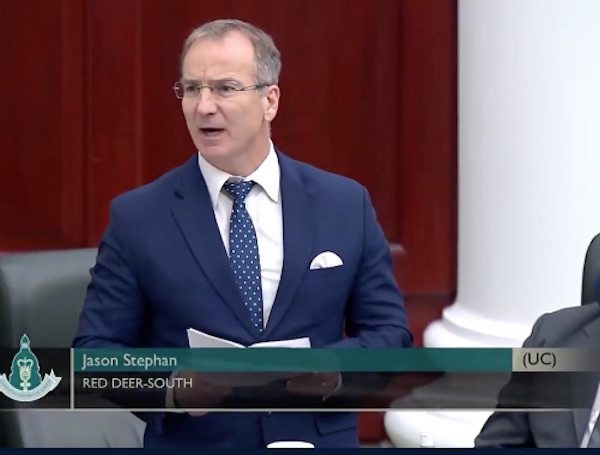Opinion
The 5 Stages to an Alberta Party Election Loss

The Alberta Party managed to attain 5x more votes than they did in 2015. Yet were the biggest losers of the 2019 election cycle. To be honest I believe we would have been well served to have the AB Party win a couple seats in the legislature. However, that is certainly not how things went down on April 16th. They gained 5x the votes and lost all three of their seats.
I have seen some curious behaviour from former Alberta Party candidates as of late and it got me to thinking: ‘What is the AB Party (both party and individual candidates) going through right now?’ Lets explore what I believe to be happening and where I think they need to go to turn (what is now a fringe party) into the opposition.
5 Stages of the Alberta Party Loss
Denial
As mentioned The AB Party went into the election holding 3 seats, hoping to build upon their party growth. What they attained was actually pretty incredible. They recieved over 5x the amount of votes they had in 2015. From 33,867 to 170,872. The response to attaining 0 seats was not surprising and was somewhat humble In my opinion. Mandel cited being proud of the AB Party brand and, frankly, they should be. However, he was wrong for blaming polarization as the reason for the loss. You cannot simultaneously gain 5x the votes and blame polarization. The one thing missing here is that there has been no recognition that their platform was extremely weak. They continue to be in denial that their ideas were not inspiring, their vision was lacking, and their boldness was not focussed on any areas of importance. The AB Party is currently in denial. I do, however, think they are moving past this. Slowly but surely.
Anger
Although we have not seen a direct example of anger from the Party we have started seeing some pretty broad examples of anger throughout the AB Party team/former candidates. I have seen individual candidates who have generally touted themselves as the calm and collected type start to lash out. I have seen insults directed towards conservatives and towards anyone who disagrees with them in general. It is clear that after a couple weeks individuals are starting to feel angry. This is to be expected it is, after all, a human trait. It is now a month after the election. Candidates who worked so hard for so long are realizing what the election cost them both financially, and emotionally. They find it freeing not to be under the “do no harm” mantra of the party system anymore and are beginning to say how they really feel. This is where the rubber really hits the road. The AB party was supposed to be different, made up of candidates who respond with thoughtfulness and consideration. The blinders are being pulled off and we are finding out that the AB party is just another party. They are no different than anyone else. They have their spin, they have their ideology, and ultimately they were fooling themselves into thinking they were different. Perhaps this is an opportunity for their candidates to prove me wrong and pull back on some of the over the top anger and remember that anger is in general, just not worth it.
Bargaining
We have seen a very very clear example of bargaining this week. The AB Party refuses to accept the fact that they are no longer in the Legislature. They have asked for money from they LAO with the intent of being a quasi opposition without a seat in the legislature. They want the funding to do the research while they no longer represent anyone. This is just part of the steps of grief that the AB Party is facing. They are trying to hold on to what once was but no longer is.
Depression
I don’t think the AB party is here yet. Depression in the party sense is devastating. We are going to see growing disinterest from individuals who gave so much before the election. We are going to see folks question ‘What is the point?’. They are going to question the AB party principles, they are going to ask themselves if they should just try to change the NDP or UCP from within. There will be some individuals who pull back and you won’t hear from them again. This is the stage that the Party’s head brass need to address head on. They need to quickly work on inspiring individuals and they need to come up with a plan to allow individuals the time to “shut-off” after a tough election while ensuring they don’t lose touch. If the depression symptom spirals out of control their party will die. On an individual sense, and with sincerity, I do ask anyone who finds themselves getting into this stage to take the time to reflect on the greater good in life. Please seek help if you need to. Depression is nothing to joke about and, yes, an election loss is a legitimate reason for someone to become depressed.
Acceptance.
I do hope the AB party is able to move to acceptance quickly. Let’s look at a few things that the AB party needs to accept.
1. They ran a terrible platform – Yes, there were things in their platform that were amenable. However, it was choppy there was no consistency. It focussed on things that Albertans didn’t care enough about. They were bold in all the wrong areas.
2. The AB party made a mistake kicking out Greg Clarke as leader – There was no opposition MLA that I liked more than Greg. Make no mistake, (while Greg may not admit it himself) Greg’s demotion was a result of a coup from old PC members who didn’t like Jason Kenney. They were quick to join the AB party and place their own person in the position of leadership. Stephen Mandel may have carried the party to 5x more votes but there is no doubt it was on the kindness and likability of former MLA Greg Clarke.
3. They cannot blame polarization for their loss – If they knew that the election was going to be a polarizing one they were perfectly positioned to create themselves as the opposing pole. Instead they positioned themselves as an outlier. The election was polarizing, yes. However, as I already said, they cannot simultaneously blame polarization while championing 5x more votes.
4. They are not different than other parties. – Trying to run a party as though Ideology doesn’t exist is a fools errand. The thought that they are going to do politics differently and its all going to turn out does not come from humility but rather just a vain attempt to pull the wool over the eyes of the public. Trudeau is a perfect example of the AB party narrative. He was going to do politics differently too. The AB party just isn’t different from other parties and the idea that they think they are is actually quite frightening.
5. They need to stop talking, and start working – The AB party is doing themselves no favours by silly maneuvers such as asking for money from the LAO. They need to stop this nonsense and come to grips with the fact that they are now no different than the FCP, the AAP, and the AIP. They should look at the votes they attained as an opportunity to fundraise, not as a passage to being taxpayer funded.
In Conclusion: There is a lot of room for the Alberta party to grow and become the official opposition in 2023. However, this will never happen if they get stuck where they are. They need to move beyond the Denial, Anger, Bargaining, and Depression stages and start to accept their failures so they can embrace the reasons for their incredible success at achieving 5x more votes than they did in 2015.
Daily Caller
John Kerry Lurches Back Onto Global Stage For One Final Gasp


From the Daily Caller News Foundation
John Kerry, one of the grandest and most persistent climate scolds of the 21stcentury, lurched back into the news this week when he was knighted by Britain’s King Charles, a prominent climate scold in his own right.
In fact, their shared efforts involving flying off on carbon-spewing private jets to lecture the masses to live smaller, more costly lives in the name of fighting climate change was the motivation for the award, as the King thanked Kerry for his “services to tackling climate change.” That seems to be a bit of a grammatical error, but when royalty is involved, no one really cares, do they?
“King Charles and I share the same point of view — that there’s an urgency to doing things,” Kerry told the Globe in an interview. “He’s been ahead of most folks on this from the time I can remember… He always had a commitment to nature.”
Unfortunately for the U.K.’s citizens, the Labour government’s “commitment to nature” mainly appears to involve covering thousands of acres of bucolic British farmland with massive solar arrays and felling thousands of forest trees to make home to big wind installations these days.
Projects like those – frequently forced by the central government on objecting rural communities – form the centerpiece of Secretary of State for Energy Security and Net Zero Ed Miliband’s program to deindustrialize the formerly formidable British economy.
That program – based on the shared philosophy of King Charles and Kerry – has sent the U.K.’s utility rates skyrocketing to the highest on earth. It has also rendered the former global power dependent on imports from foreign nations for its energy security, with China the most prominent among them.
Such are the fruits of the King Charles/Kerry “point of view.” Most would agree with Kerry’s statement that “there’s an urgency to doing things.” The problem is that pretty much everything he and the King have been doing in this realm across the first quarter of the 21st century leads inevitably to serfdom to the Chinese Communist Party.
In an interview with the Financial Times the same day, Kerry repeated much of the tiresome dogma of his alarmist religion, in the process excoriating President Donald Trump as a “denier” and calling U.S. corporate leaders cowards for straying from the narrative he and the King prefer. “It is not that they don’t believe [in climate change] or they don’t want to move forward. They are just scared,” Kerry said of the corporate CEOs, adding, “The process of Donald Trump in the last months, coupled with the justice department, coupled with his vengeance programs, has scared… a lot of people.”
But a more believable alternative explanation for the shift away from the twin manias of ESG and DEI by many companies in recent years is that these corporate leaders have a fiduciary duty to maximize returns on capital to their investors. The problem for Kerry and his disciples is that the preferred alternatives they have advanced too often devolved into unprofitable boondoggles that fail to satisfy that duty. Kerry wants to place the entire blame on Trump – who, ironically, was recently honored by King Charles himself with an unprecedented second state dinner. But the truth is that shift started in earnest in 2023, when Joe Biden’s autopen was still in charge of the ship of American state.
That shift has certainly accelerated this year, as companies have been freed from the incessant hectoring of the Biden government and are now being denied access to the ruinous green subsidies from the IRA that so radically distorted energy markets. This has little to do with climate denialism or cowardice and much to do with sound business practice and CEOs properly carrying out the mandates of their high positions. No amount of hyperbolic talking points from Kerry or the King can change that reality.
In the end, Kerry’s remarks come off as a lot of sound and fury signifying nothing. Now in the twilight of his career, he has become a relic, a totem of a fading global religion whose end cannot come soon enough.
David Blackmon is an energy writer and consultant based in Texas. He spent 40 years in the oil and gas business, where he specialized in public policy and communications.
Daily Caller
‘No Critical Thinking’: Parents Sound Alarm As Tech Begins To ‘Replace The Teacher’


From the Daily Caller News Foundation
Parents are growing increasingly concerned about the prevalence of technology in classrooms, and the negative side effects that change is fueling among children nationwide.
Ever since the COVID-19 pandemic pushed schools to remote learning, many have only grown increasingly reliant on technology, shifting assignments into digital forms and handing every student a computer or tablet to aid their education in the classroom. But after seeing their kids become angrier, less sociable and less educated, parents are asking where the teachers have gone.
“What are we doing with an iPad all day, for eight hours a day in our kids’ hands?” Patricia McCoy, a mother of four in Wyoming, told the Daily Caller News Foundation. “Honestly, it’s disturbing. They give your kids worksheets on the iPad. There’s no actual critical thinking happening because they’re given apps to replace the teachers.”
Even when parents ask for additional help for their struggling children, the solution at some schools always comes back to more technology.
“If your kid is struggling in math, instead of giving them tutoring, they’re going to recommend to you that your child use this app on their iPad to help teach them how to do this math,” McCoy continued. “But that app doesn’t teach them how to do the math. They enter the problem and it gives them the solution all written out and worked out, so there’s no critical thinking being done. The answer is being given to them. They have ChatGPT at the ready, and other things similar to ChatGPT, which, again, does all the thinking for them. And all they have to do is show up, log into the iPad, get the answers from one app, put it into another app and get the grade.”
This has some parents wondering where the teachers have gone and whether they are teaching their students at all.
“THEY DON’T WANT TO TEACH”
“Covid did create a lot of this, and it made it a lot easier for some of the teachers now to just place these kids in front of a screen,” Mike Maldonado, a California father of five, told the DCNF. “And it makes it easier for some of these teachers because they don’t want to teach. They’re just there for a job.”
“We can’t ignore the fact that all this stuff makes it easier on the teacher, which actually, I think produces a worse result, “Jaime Brennan, member of the Frederick County Board of Education who spoke on behalf of herself and not the board, told the DCNF. “When a teacher can go online and make up an assignment using AI, now they haven’t thought. Now they’re not using their brainpower, and it’s like a trickle down effect. We’ve already introduced screens and technology to the level that as humans, I don’t think we were designed to use, and we haven’t adapted to it very well.”
Critically, Brennan said, the use of AI has prevented students from developing automaticity, the skill of memorizing basic solutions, such as simple addition, to the point that you do not even think about it, which is a foundational skill students carry on throughout their education and adult life.
McCoy told the DCNF that the digital learning environment has left her youngest son academically “two to three years behind” his siblings, who did not go through this new screen-based school system.
“He is drastically farther behind academically,” McCoy said. “He does what he needs to to pass, but intellectually and academically, he is years behind his two brothers and his sister at this age, and that is sad and heartbreaking as a mother to know that I probably failed my child because I went along with what the school said was going to help them.”
Despite being “years behind,” McCoy’s son is on track to graduate on time.
“We graduate kids who have to go to community college and take remedial math,” Brennan mentioned. “Our kids leave 12th grade and they go to 13th grade. So we’re putting out kids that are not ready to operate in the regular world.”
POSSESSED BY THE SCREEN
Not only is she worried about his education, the concerned mom has seen a noticeable shift in her son’s mood as he is forced to rely on more and more screen time.
“I tried to take my son’s phone away one time, and it looked like a demon was looking back at me. My son was not looking at me,” McCoy recalled. “His eyes were completely black and cold. It was like he was a totally other person, like a drug addict, and you’re taking their drug from them. And he was 15 at the time.”
Without his phone, McCoy said her son was a new person.
“That week, he was a totally different person. He wasn’t overly tired and drowsy all day. He was actually interacting with the family and spending time with us. Instead of being shut down and closed off in his room, he was playing with our dogs more,” McCoy said.
Maldonado thinks these behavioral issues stem partly from the lack of human interaction children experience in increasingly screen-dependent classrooms.
“Part of the problem is that they’ve lost a lot of the interaction,” Maldonado said. “This is why some of these kids I think act out, because they don’t want to listen to the teacher. There has to be that communication between two people, two humans, and not a screen where they can’t really interact and get the tone, the voice inflection of a response.”
“That is a major issue,” Maldonado continued. “Without social skills, how do you function in society? And we see it all the time. Social skills are definitely learned, it’s a trait that you pick up from interacting with people when you’re young. And that’s the big thing, people don’t realize that if there’s no interaction, that person is going to be withdrawn, not just from the classroom, but from the home and from society.”
The issue is especially apparent in children who were younger during the Covid year, Maldonado said. The so-called “Covid babies” are typically “the ones who you can see have the majority of the behavioral issues.”
“It is hard to get some of these kids to actually look you in the eye and make eye contact. They don’t know human interaction,” Brennan concurred, adding that students today are not even dating as much as they used to. “I’m really concerned where that’s going to lead, and what our kids are going to be like. We’re already seeing negative impacts of kind of this disintegration, people are waiting till later to getting married. They’re not getting married.”
THE PRICE AMERICA IS PAYING
Meanwhile, as the use of artificial intelligence (AI) among youth increases, more data and stories are coming out revealing the tool often exposes children to inappropriate content, damages the development of critical thinking skills, and at times, drives kids to suicide by explicitly coaching them to do so. Brain scans from the Massachusetts Institute of Technology (MIT) revealed that brain engagement was severely diminished under participants who used AI compared to those who used a traditional search engine, and memory recall following assignments completed with AI tanked.
Interestingly, schools that struggle with budget concerns and often fail to see promised district-wide staff raises somehow find funds to buy brand-new devices for every student — even when they already had slightly older, but still functional devices.
“Most of [the money goes] to administration and fees and other things that have nothing to do with the education of our kids, or they spend it on these expensive iPads and technology that shouldn’t even be in the classrooms, and then they go to the state and say, ‘You’re not giving us enough money. We need more money,’” McCoy told the DCNF. “Well, we keep throwing money at the problem, but the problem doesn’t get better or go away. It gets worse every year. So clearly, money isn’t solving the issue on why our kids can’t read, write and do math.”
“Stop spending the money on the iPads and put that money back in the classrooms instead,” McCoy continued. “Give it to the teachers.”
While Tina Descovich, co-founder and CEO of parental advocacy group Moms for Liberty, mirrors the concerns of many parents, she also told the DCNF there could be a place for technology in the classroom.
“I think they have to be used in a very responsible fashion,” Descovich said. “There’s so many wonderful teachers that would like to use AI in a way to help enhance their skills and teach their children better.”
Moms for Liberty signed a pledge with the White House in September to help foster innovation and interest in AI with America’s youth.
Brennan remains concerned that technology in the classroom prevents kids from thinking independently and may harm future skill building rather than facilitate an interest or expertise in technology.
“Are you trying to keep pace with the kids who are learning to use the technology, or are you trying to create the kids who are going to develop the technology? Because those are two different things,” Brennan said. “So if we’re just teaching our kids to be technology consumers, then sure, the easy way out is to do everything on the technology. If you’re trying to keep teach kids to be the technology developers, they need to learn to think and process away from the technology. They need to have other skills that are not technology based.”
PARENTS STILL HAVE POWER
For parents concerned about the technological takeover of their children’s classrooms who feel like their schools aren’t listening to them, Descovich said that along with helping their kids at home when possible, parents should “rally with like minded parents.”
“Start educating your community,” Descovich said. “I think when parents really understand what’s happening and what the concerns are and what the risks are, they will want to take action. And when you have enough parents showing up at school board meetings and speaking about an issue we have, as we know, you definitely can make an impact, and they will listen.”
-

 Alberta1 day ago
Alberta1 day agoFrom Underdog to Top Broodmare
-

 Opinion9 hours ago
Opinion9 hours agoLandmark 2025 Study Says Near-Death Experiences Can’t Be Explained Away
-

 Focal Points10 hours ago
Focal Points10 hours agoSTUDY: TikTok, Instagram, and YouTube Shorts Induce Measurable “Brain Rot”
-

 Alberta8 hours ago
Alberta8 hours agoRed Deer’s Jason Stephan calls for citizen-led referendum on late-term abortion ban in Alberta
-

 Health11 hours ago
Health11 hours agoTens of thousands are dying on waiting lists following decades of media reluctance to debate healthcare
-

 Indigenous7 hours ago
Indigenous7 hours agoIndigenous activist wins landmark court ruling for financial transparency
-

 COVID-192 days ago
COVID-192 days agoCanadian government seeking to destroy Freedom Convoy leader, taking Big Red from Chris Barber
-

 National2 days ago
National2 days agoQuebec proposes to ban public prayer, harden laws against religious symbols



